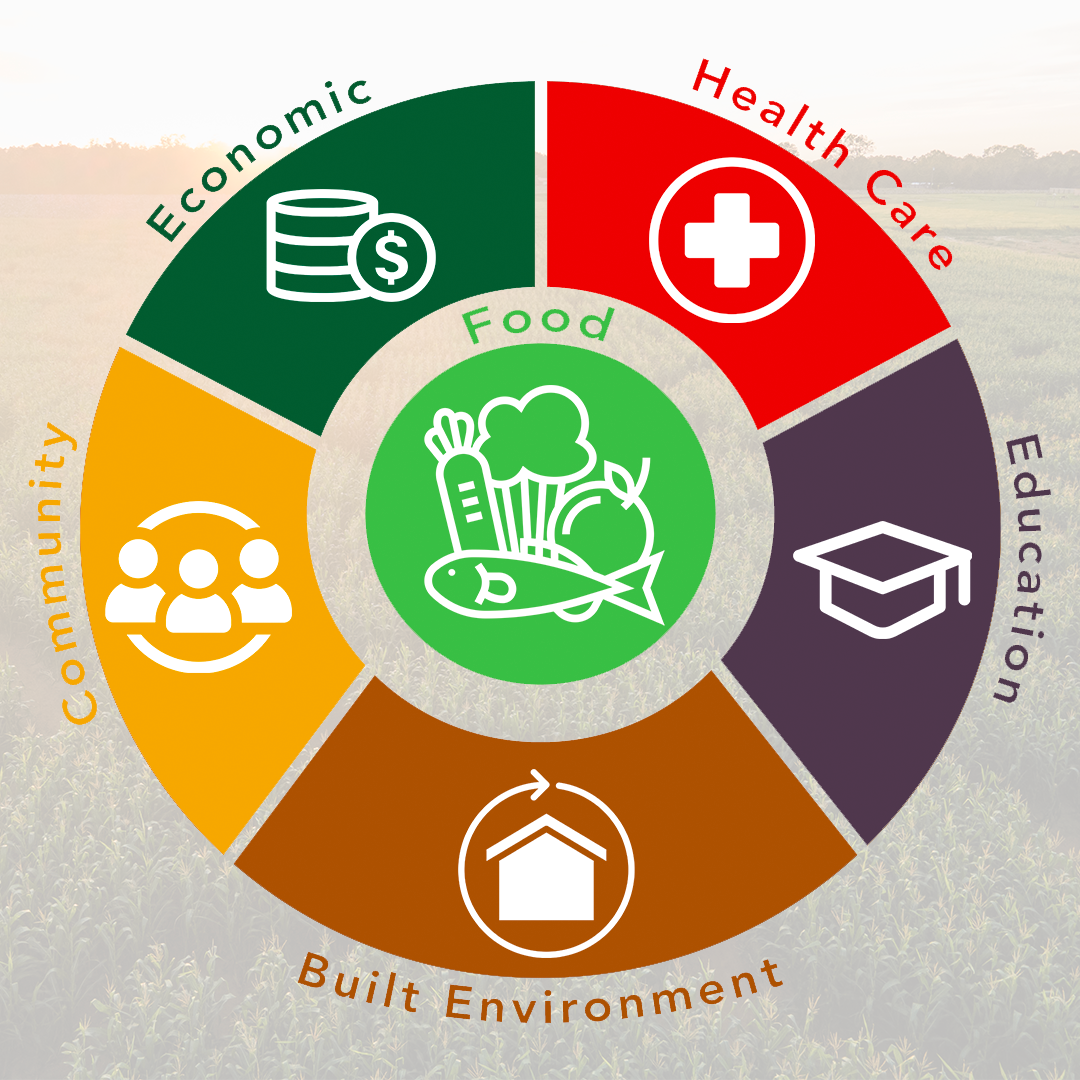
Social Determinants of Health

By: Joe Greenwald - Business Development Strategist
January 12, 2022
Government agencies, health professionals, policy makers, academics, and other experts often refer to Social Determinants of Health. They are generally presented as equally important puzzle pieces in a larger picture. But when one takes a deeper look, it becomes apparent that not all determinants should
be viewed as equal. A better model might be a hub and spoke with food at the center.
Social Determinants of Health are important to address when looking to improve community health outcomes and reducing health disparities. For example, people who lack access to grocery stores with healthy food are less likely to have good nutrition. This increases the likelihood that they will experience health conditions such as heart disease, diabetes, and obesity which can, in turn, lower their life expectancy.
Similarly, children born into families in a lower socio-economic environment are more likely to encounter barriers to health such as lack of safety, exposed garbage, and substandard housing. They are also less likely to have access to sidewalks, parks, playground, and other community resources which
promote health outcomes.
Although several different models for Social Determinants of Health can be found, they are generally similar in basic content. The six categories presented by the Kaiser Family Foundation are a good representation of what are typically identified as the determinants.
Economic Stability considers the financial condition of a person. It includes attributes such as access to employment, income level, living expenses, amount of debt, and medical bills.
Neighborhood and Physical Environment looks at living environment. This recognizes the impact on health outcomes of factors such as type of housing, access to transportation, neighborhood safety, availability of parks and playgrounds, and walkability.
Education recognizes the impact of learned skill sets. The ability to maintain health is impacted by literacy, ability to communicate in the local language, early childhood education, vocational training, and access to higher education.
Food, which we will discuss more below, addresses hunger, food insecurity and having access to healthy options.
Community and Social Context recognizes the impact of relationships and interactions with family, co-workers, and community members. Health can be impacted by social integration, availability of support systems, degree of community engagement, impacts from discrimination, and social stress.
Health Care System considers access to the health care services individuals need. Some of the factors that should be considered include obtainability of health coverage, provider availability, provider linguistic and cultural competency, and quality of care.
Each of these Social Determinants of Health is important to understand when considering the well-being of our communities. On the surface they may also seem to carry equal weight. But one stands out as being more foundational than the others. Access to nutritious food.
One can, arguably, survive in the absence of the other determinants. For example, economic stability certainly contributes to better health outcomes. However, people can survive without it. Similarly, with other determinants one can still hope to survive even in the absence of appropriate resources. But this is not true of food. One cannot survive for a meaningful period without food. And access to nutritious food is an enabler for the other Social Determinants of Health.
Securing Economic Stability is not practical without access to nutritious food. A job that enables a stable income is a key component of creating economic stability. Being a productive employee who can retain a job requires access to food that allows the mind and body to function at their highest levels.
A community that does not provide adequate access to food is also likely to struggle in providing a suitable Neighborhood and Physical Environment. When people are faced with challenges of food insecurity, contributing to a stable neighborhood environment becomes challenging. In “An Examination of Food Insecurity and Its Impact on Violent Crime in American Communities (2016)” published at Clemson University, a study showed a 12 percent increase in violent crime rate for every one percent increase in food insecurity. While research in this area is very limited, there appears to be a causal relationship between food insecurity and undesirable neighborhood conditions.
The impact of nutritious food on Education is very similar to the impact on economic stability. It has been shown that children who grow up in food insecure households often lag behind their peers in terms of cognitive, emotional, and physical development. A wide body of research shows that these consequences also follow children into the classroom. And the impacts continue past K-12 education; workers who experienced hunger as children are not as well prepared physically, mentally, and emotionally to perform effectively in the workforce.
Food insecurity may also have negative implications for Community and Social Context. A significant contributor to poor relationships, including those with family, co-workers, and community members, is social stress. An article published by the US National Library of Medicine comments, “A growing body of
research suggests that food insecurity is associated with poor mental health outcomes, including depression, anxiety, and stress.” The stress created by food insecurity inhibits the ability of people to productively engage with community resources and support systems.
The ability to get positive outcomes from Health Care Systems is also reliant on access to nutritious food. Many people that have health conditions require access to food that meets specific dietary restrictions.
Even in the absence of dietary restrictions the need for nutritious food is a basic requirement for ensuring desirable health outcomes. Even for those without existing health conditions, access to nutritious food is essential for health maintenance.
While the strength of our communities requires we address all the Social Determinants of Health, it is critical that we establish a foundation of universal access to nutritious food. It is the one social determinant which is essential to preservation of life. Food is also a building block for all the other determinants.
At Abound Food Care we view Food as the hub around which the other Social Determinants of Health are built.
Click here to learn more about Abound Food Care’s solutions to food waste and insecurity.


